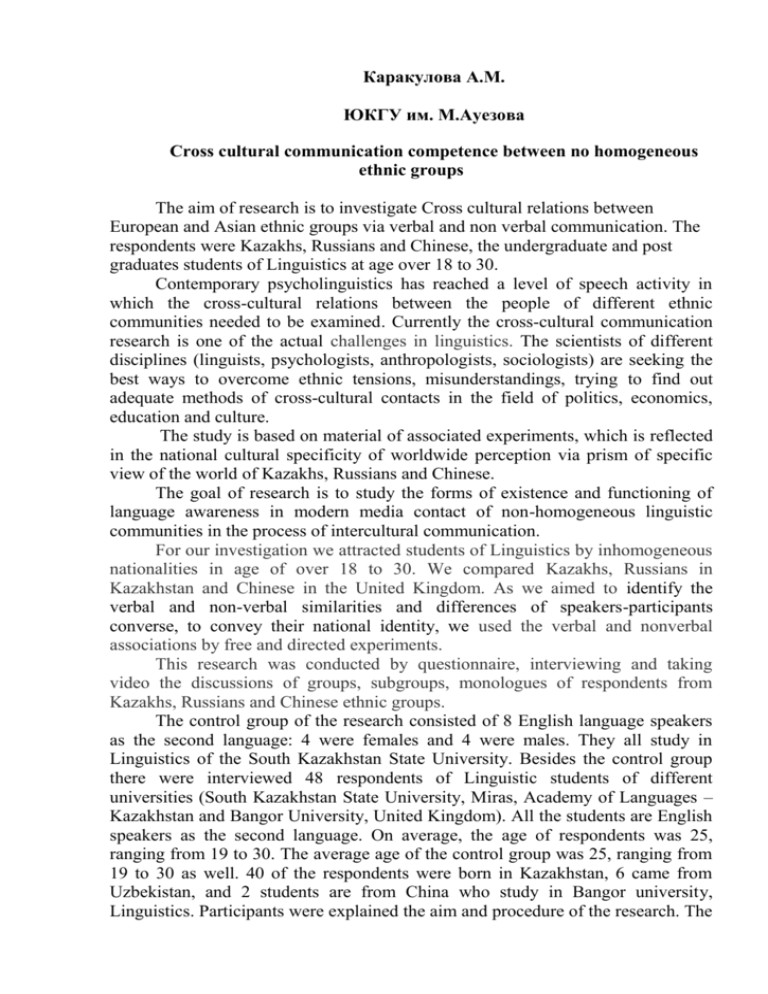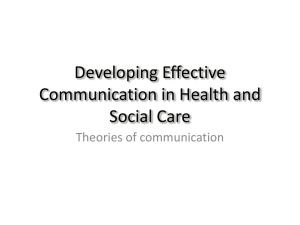1. Comparing Kazakhs, Russians and Chinese we see the universal
advertisement

Каракулова А.М. ЮКГУ им. М.Ауезова Cross cultural communication competence between no homogeneous ethnic groups The aim of research is to investigate Cross cultural relations between European and Asian ethnic groups via verbal and non verbal communication. The respondents were Kazakhs, Russians and Chinese, the undergraduate and post graduates students of Linguistics at age over 18 to 30. Contemporary psycholinguistics has reached a level of speech activity in which the cross-cultural relations between the people of different ethnic communities needed to be examined. Currently the cross-cultural communication research is one of the actual challenges in linguistics. The scientists of different disciplines (linguists, psychologists, anthropologists, sociologists) are seeking the best ways to overcome ethnic tensions, misunderstandings, trying to find out adequate methods of cross-cultural contacts in the field of politics, economics, education and culture. The study is based on material of associated experiments, which is reflected in the national cultural specificity of worldwide perception via prism of specific view of the world of Kazakhs, Russians and Chinese. The goal of research is to study the forms of existence and functioning of language awareness in modern media contact of non-homogeneous linguistic communities in the process of intercultural communication. For our investigation we attracted students of Linguistics by inhomogeneous nationalities in age of over 18 to 30. We compared Kazakhs, Russians in Kazakhstan and Chinese in the United Kingdom. As we aimed to identify the verbal and non-verbal similarities and differences of speakers-participants converse, to convey their national identity, we used the verbal and nonverbal associations by free and directed experiments. This research was conducted by questionnaire, interviewing and taking video the discussions of groups, subgroups, monologues of respondents from Kazakhs, Russians and Chinese ethnic groups. The control group of the research consisted of 8 English language speakers as the second language: 4 were females and 4 were males. They all study in Linguistics of the South Kazakhstan State University. Besides the control group there were interviewed 48 respondents of Linguistic students of different universities (South Kazakhstan State University, Miras, Academy of Languages – Kazakhstan and Bangor University, United Kingdom). All the students are English speakers as the second language. On average, the age of respondents was 25, ranging from 19 to 30. The average age of the control group was 25, ranging from 19 to 30 as well. 40 of the respondents were born in Kazakhstan, 6 came from Uzbekistan, and 2 students are from China who study in Bangor university, Linguistics. Participants were explained the aim and procedure of the research. The students were informed their rights, terms and conditions which were agreed by all of them. The questionnaires and interviews were voluntary and not anonymous. Students gave their names, age, occupations, moreover, they are not against that they will be looked at the video to a large audience. The scientific project is devoted to the study of cross cultural communication between European and Asian ethnic groups speaking in languages of different systems that will identify universals of verbal and nonverbal communication. Work is performed in line with contrastive studies of cognitive linguistics. The research is focused on images of non-homogeneous cultures and consciousness with verbal associations. Contemporary psycholinguistics has reached a level of speech activity in which the cross-cultural communication problems between representatives of different ethnic communities needed to be solved. The recent upsurge of interest in the problems of intercultural communication caused by external (pragmatic) and internal (scientific) problems. The object of the study are images of consciousness of non-homogeneous cultures, externalized verbal and non verbal associations. Such a study of the forms of existence and functioning of language awareness in Lingual cultural inhomogeneous medium is based on the large amount of material association experiments, which is a reflection of the cultural identity of perception of the real world through the lens of specific images of the world - members of different images of consciousness. For our investigation we attracted students of Linguistics by inhomogeneous nationalities. We compared Kazakhs, Russians in Kazakhstan and Chinese in the United Kingdom. As we aimed to identify the verbal and nonverbal similarities and differences of speakers-participants converse, to convey their national identity, we used the verbal and nonverbal associations by free and directed experiments By nature the cross-cultural communication is always interpersonal communication in a special context, when one side finds another cultural difference. Intercultural communication is based on a process of symbolic interaction between individuals and groups, cultural differences. Perception and attitude to these differences affect the appearance, form, and the result of contact. Each participant of the cultural contact has its own system of rules that operate in such a way that the sent and received messages can be encoded and decoded. Signs of cultural differences can be interpreted as differences of verbal and non-verbal codes in the specific context of the communication. On the process of interpretation, in addition to cultural differences affect the age, gender, profession, social status of the communicant. Therefore, the degree of each specific act of intercultural communication depends on tolerance, enterprise, and personal experiences of the participants. The results of this study allowed us to formulate the following: 1. Comparing Kazakhs, Russians and Chinese we see the universal features such as informality, warmth, personal approach to communication. As it turned out, the individual phenomena in the verbal behavior of the Kazakhs explained the influence of Islam. 2. In contrast to the Kazakhs and Russians, the specificity of the speech of Chinese etiquette is that they have an important place among the typical speed of speech etiquette occupy the expression of gratitude and reverence. Chinese-students temporarily living in the UK, may have learned from local residents their mimics and gestures, who from early childhood mechanically grafted gratuities, smile, an apology. In interpersonal communication that gives a sense of mutual respect, feelings of warmth and kindness, but at the same time allows to keep a distance between the communicants. 3. Speaking of non-verbal means of speech communication, we note that the facial expression of the essential emotions are universal in all three lingual cultures. Culturally specific functions and features are smiling: the Chinese smile – 1) this is a formal sign indicating linguistic culture, 2) and biological sign of positive emotions. As for Kazakhs and Russians – they include often to only the latter. If in the Kazakh and Russian communications smile has, as a rule, personal symbolism, the Chinese communication - a sign of social symbolism. 4. We presented the typological common and national specific gestures (unique to a particular linguistic culture), attracting attention, gestures, that make explicit attention to the interviewee, the gestures of uncertainty, confusion, tension. Pace, intensity of movements, illustrative speech prevail in the European lingual culture (Russians): it means expressiveness and intensity of gestures, freedom and openness of hand movements. 5. Globalization, the influence of Mass media, movies, intercultural communication have the great influence on young people that lead to universalize their gestures and facial expressions. Gestures, facial expressions and words which are not permitted rules of etiquette in recent years are forgotten in favor of borrowed traditions and cultures. Cultural identity sign has a big impact on the efficiency of the communication process. The study of non-verbal communication contributes to a better understanding of foreign language culture, the formation of tolerance to all participants in the act of communication, improve the efficiency of cross-cultural communication and dialogue between cultures in the modern world. Comparative analysis of verbal and non-verbal associations of non homogeneous ethnic groups lead to the following conclusions. Non-verbal communication, beyond a linguisticcultural community, is faced with the problems of decoding codes, which can be interpreted according to the existing knowledge of the recipient, acquired as part of its national culture. Culturally specific communicative competence promotes mutual "agreement" on the interpretation of non-verbal communicators of values. Mimic display basic emotions are universal in all ethnic linguistic cultures. As we have mentioned the facial expression of the essential emotions are universal in all three lingual cultures. Culturally specific functions and features are smiling: the Chinese smile – 1) this is a formal sign indicating linguistic culture, 2) and biological sign of positive emotions. As for Kazakhs and Russians – they include often to only the latter. If in the Kazakh and Russian communications smile has, as a rule, personal symbolism, the Chinese communication - a sign of social symbolism. A comparative analysis of similar gestures used in the everyday communication for most people, indicates that the gestures used in similar situations, representatives of various linguocultures rarely coincide. It is identical in shape, they may differ in content. The minimum number of nationally specific gestures in the two linguistic cultures have been among gestures approval, denial, attention, invitations, directional gestures and gestures that transmit uncertainty, confusion, tension, expressing sympathy. Based on the above, we can conclude that the non-verbal means of communication are equally important in the process of communication than verbal and carry a huge amount of information. Thus, valid speech acts from communicators are not possible without knowledge of the rules of speech etiquette and ability to follow them. This is further proves the need for a comparative study of intercultural communication in order to avoid language and cultural barriers in communicating real representatives of these cultures. Currently the economic and political interest in the joint multi-ethnic coexistence of multinational states began to prevail over cultural and national selfinterest and ethnocentrism. The economic integration of advanced developing countries encourage the creation of joint ventures, commonwealths, branches of national companies, which necessitated the use of multiple and diverse forms of cross-cultural contacts in the field of politics, economics, education and culture. The scientists of different disciplines (linguists, psychologists, anthropologists, sociologists) have to seek the best ways for overcoming ethnic tensions, misunderstandings - adequate forms of intercultural communication. References: 1 Berns, M. 1988. ‘The cultural and linguistic context of English in West Germany. World Englishes 7/1: 37–49. 2 Bex, A. R. 1994. ‘The problem of culture and English language teaching in Europe’. IRAL 32/1: 57–67. 3 Canale, M. 1983. ‘From communicative competence to communicative language pedagogy’ in J. C. Richards and R. W. Schmidt (eds.). Language and Communication. London: Longman. 4 Crystal, D. 1985. ‘How many billions? The statistics of English today’. English Today 1: 7–11. 5 Hyde, M. 1998. ‘Intercultural competence in English language education’. Modern English Teacher 7/2: 7–11. 6 Kachru, B. 1986. The Alchemy of English. Oxford: Pergamon Press. 7 Kramsch, C. 1995. ‘The privilege of the non-native speaker’. Plenary address at the Annual TESOL Convention, April, Long Beach, California. 8 Kramsch, C. and P. Sullivan. 1996. ‘Appropriate pedagogy’. ELT Journal 50/3: 199–212.










